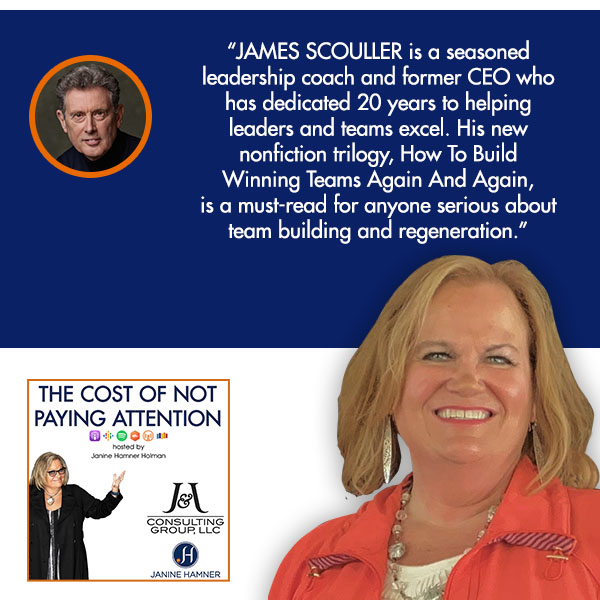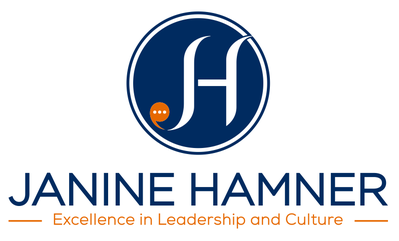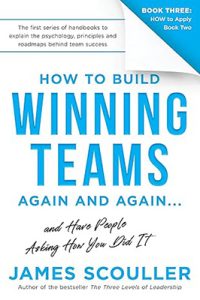
Team psychology is like a puzzle, with each member contributing to the team’s success. Understanding how these pieces fit and interact is essential for creating a winning team. In this episode, Janine Hamner Holman welcomes James Scouller, an executive coach and author of the trilogy How To Build Winning Teams Again And Again. James delves into the critical role of team building and regeneration in company success. Discover why neglecting team psychology can lead to subpar performance and costly consequences. Tune in for a deep dive into how understanding team psychology can transform workplace culture and drive exceptional results.
GUEST: James Scouller | LinkedIn | Visit their Website: Leadership Mastery Suite
HOST: Janine Hamner Holman | [email protected] | LinkedIn, Facebook, Instagram, and Twitter | Subscribe to my Newsletter! | Book me to Speak!
—
Listen to the episode here
The Winning Team: Unlocking Team Psychology With James Scouller
Inattention In Teams
James Scouller is an ex-CEO, who has been coaching leaders and their teams for twenty years. He has released something unusual in the world of books, a non-fiction trilogy. It’s titled How To Build Winning Teams Again And Again. He says these are the three books that he wished he’d read many years ago. If you stick with us until the end of the episode, our audience is going to get extra goodies from James. Please stick around.
James, what is the one thing that you have noticed either within your business or more likely working with clients? What’s the one thing that they have been failing to pay attention to, and what’s the cost of that inattention? What’s the problem that that inattention is causing?

I know you ask all your guests that, and I suppose all of us want to range over a whole list, but I will comply and I will say one thing, and not surprisingly for the purpose of this show. I would say that the number one thing my client companies don’t pay attention to is learning and practicing the art of team building and team regeneration. Why do I say that? Think about it for a moment. Once you get beyond the startup stage, every company’s success depends on its ability to mesh the various skills, experiences, know-how, and energy of the people in different departments and different countries. In other words, it’s all about company-wide collaboration. If you think about it, what is the basic building block to company-wide collaboration? It is, of course, the various teams in the business.
The number one thing some companies don't pay attention to is learning and practicing the art of team building and team regeneration. Share on X
Yet we expect doctors and architects to learn their trade for 6 or 7 years and lawyers for about 5 or 6 or six years, accountants for 3 years or so, yet we stroll into a room and somehow expect to wing it and become a high-performing team. You are chuckling because you can see how ridiculous it is when it’s exposed like that. When I talk to clients, I don’t say it all the time because it can be embarrassing, but I have asked, “How long have you spent consciously learning and practicing how to build and regenerate teams?” I start at, say, 2 months, then I bring it down to 1 month, 2 weeks, 2 days, and 1 day. You’ve probably guessed.
Some of them sheepishly admit that they’ve had maybe a day bonding in the woods or something, but most of us have had absolutely no training at all. You’ve got this thing, team building and team regeneration, which has an enormous difference. It makes an enormous difference to the results of companies and our working lives. What’s the cost of not paying attention to it? The cost is the incalculable improvement in results we would get if we were consistently good at building teams again and again, company-wide. I can’t put a number on that, then the other cost is what happens when we have to put up with mediocre or terrible teams, which all of us have worked in. What happens to our mental health? What happens to our commitment? What happens to our wish to stay? We leave, you can put a cost on that. Either way, those costs are enormous.
Ginormous, maybe! They are incalculable. You and I were talking before we started recording, I got back from facilitating a three-and-a-half-day board retreat with a board of directors. One of the things that we ended up talking about, this board has been in place with these exact people for a little over a year and they don’t know each other very well, or at least some of them don’t. The newer board members aren’t entirely clear on what the business is about. They were recruited to join the board, and now they’re on the board, but like, “Exactly what are our values? How do we, what’s our organizational culture? Why does it matter?” One of the things that got revealed over the course of those three-and-a-half days is that this board needs to, is going to get to spend time together as a board, not working, but getting to know each other and getting to know what matters.
One of the things that we talked about is that we normally spend, in most cultures, zero time with new managers. We say, “You are great at doing your job and now we are going to elevate you. You’re going to lead this team. Good job. Ready go.” We don’t help them understand how to lead or manage anybody, a lot of mischief then ensues what you are doing, which I love, is taking that understanding and, “Let’s then apply it to teams and what happens when we are an untrained manager who’s now leading a team of people who are working on getting something done?” In today’s day and age that team might be widespread. Many of them may not come to an office, they may be working from home. The challenges of how to do that well have become more and more complicated. I have a hunch that may be part of what led you to write this trilogy.
The reason for writing the trilogy goes back to what I was saying. This has team building skills in team building and team regeneration. Remember, every team dips, no exceptions. You can see this in elite sports teams in your country and mine, it’s perfectly normal. You have to learn the building and the regeneration aspects. This is enormously important to companies. It has a huge effect on what our working life feels like. We pay so little attention to it.
It was certainly my observation that there are very few good teams out there, particularly at senior level. Now some very good research was published in 2015 in Harvard Business Review. The bottom line is that 75% of teams failed. This was a rigorous study and I wasn’t in the least surprised. I thought the figure would be higher. It was the incredible importance of the subject. The fact that it was being ignored led me to think, “Why doesn’t somebody unpack this psychologically?” and then suggest a way of dealing with those psychological issues. In the end, I voted myself in.
The Psychology Of Teams
I want to get into now the psychology of teams and the psychology of where teams break down, what is happening in the 25% of them when they are succeeding and what have you learned.
That is a simple question with a massive answer that cannot be contained by this episode.
Give us a few points of things that you have learned.
The number one thing is below the bonnet, as we would say in Britain, or below the hood as you would say in America. There are powerful hidden psychological forces swirling around that if you don’t address them, will make team formation and team success highly unlikely. That is the number one thing. I have a go very early on in book one of the trilogy. It is a trilogy, not one book, giving people a one-chapter explanation of what these forces are.
Very quickly I divide them into the individual forces and the collective forces, the individual forces stem from in large part negative limiting beliefs about ourselves and the world, which drive fears, which drive us into defensive behaviors, which get in the way of team formation and success. Very simply put the collective forces, which have been known about for up to 120 years, but haven’t been grasped in business, are the forces we create when a work team comes together and we start to build a story around our values, capabilities, purpose, and identity.
These things develop whether you talk about them consciously or not. You can’t not have them appear. These forces, although they’re created by the individuals, usually out of awareness subconsciously. Dr. Frankenstein creates the monster, but the monster eventually comes back to dominate and threaten Dr. Frankenstein. That’s exactly what these collective forces do. For example, it is collective forces that can cause groupthink, which can cause a team to agree to ridiculous goals or extremely bad plans. There was a wonderful study from the early 1960s on the Bay of Pigs fiasco. When very capable people, including your president, John F. Kennedy signed up for a plan that turned into an embarrassment in Cuba.
It was a terrible plan.
That’s point one. There are powerful forces under the hood, and if you don’t understand them, you’re going to end up a victim to them. That’s all you need to know. You don’t need to memorize the model I’ve described. I make that big point. If you don’t understand that there are these forces, you’re going to end up victim to them. The second big model says, “Let me give you something that helps you diagnose what’s happening so that you can apply the actions that are most important to you.” That’s where I spend most of my time in the rest of the three books, The Model, and on what you do about it.
There are powerful forces under the hood, and if you don't understand them, you're going to end up a victim to them. Share on X
If you think about it, a workgroup is not necessarily the same as a team, but certainly, a team has to face up to three psychological issues to get up the curve and stay as a high-performing team. The issue is what I call Combine. The easiest way of describing this is to list the questions that we’re subconsciously asking ourselves when we join a new team. It could be new to us or it could be new to everybody. This is Combine.
If you think about it, recall a team that you joined for the first time. You may not have been aware of it, but you are asking yourselves questions like, “What’s this team going to be like? Is it going to be a good team? What’s our aim here? Do I agree with that aim? Do I care about that aim? How does the leader respond to me? What does the leader seem to think about me? How do the others respond to me? Do I feel included and wanted here? Can I sense a possible added value role for myself?” That’s the stuff that is rattling around.
Trust is not an issue at this point. That’s one of the interesting things, because it all comes down to this, “Am I psychologically in or out?” That’s a simplification, but that’s what it comes down to. When we’ve decided, “I feel noticed here. I feel included here. I understand what we’re trying to achieve and I like it and I want to engage with it. I think I can sense a role for myself in this group, in this team where I can add value. For now, help me in.” When you’ve got enough people through that issue, then the second issue looms into play. I call it combust. Combust is about power.
The best way, simplest, and quickest way to describe this is again, to ask the questions that we’re asking ourselves, but subconsciously around this second issue. Here we’re asking ourselves questions like, and I hope some of these resonate with your readers, “How do we make decisions here? Who makes the decisions? Who’s involved? Do I agree with those decisions? What are the rules here? Do I have to fight anybody? Can I make the rules? Can I bend the rules? Can I ignore the rules? What is my role here in relation to the decisions and the follow through on the decisions, and am I happy with that?”
That’s what we’re wrestling with in combust I call it combust because this is a time of struggle, potential conflict, and very often passive-aggressive conflict. You rarely see shouting and screaming in certainly management teams. It’s more silent elephant-in-the-room stuff. By the way, this combust issue doesn’t rise to the surface until the commit has been adequately dealt with because if you think about it, who’s going to bother combusting when they don’t give a damn about the group and the work team?
If I’m not in, I’m not going to fight.
That doesn’t mean you’re not in physically. You might be in the room and very often we have to be in the room. That doesn’t mean you are psychologically in.
“I haven’t bought in yet.”
How does combustion resolve itself? Combust resolves itself when we’re saying to ourselves subconsciously, “I understand how we make decisions here. I’m okay with that as a process. I’m okay with my degree of influence over the decision-making. I’m okay with my degree of influence and creative contribution in the follow-through and execution of those decisions. I can see from all this that a sense of order and structure has emerged, and I’m okay with that.” That’s the combust issue essentially around power. The first one was a commitment that was essentially around engagement. The third issue comes through the fog and lands. This is slightly more complex. Think of this as a two-sided, well as a coin with two faces.
The first side of the coin is about trust. The second side of the coin is about focus. Now this is where trust comes in. The much talked about psychological safety. This is where we are saying to ourselves, “I know what we’re trying to achieve here. I know how we make decisions here. I’ve got a valuable role for myself and I’m okay with that role and my degree of power and influence in this place.” Can we tell the truth here? If we think this is a DAF goal or a DAF plan, is it safe to say that? Who is telling the truth here? Can I be myself and still be liked and trusted and included here? That’s what’s going on. This is very much the psychological safety trust thing.

Team Psychology: The first side of the coin is about trust. The second side is about focus.
We navigate through that first half of combined when we’re saying, “It is safe for me to say what I’m genuinely thinking and what I’m genuinely feeling. It’s okay here.” The second aspect of combine comes in, which is what I call focus. You see throughout Commit Combust and the first half of Combine, all of the attention has been on my needs, concerns, and fears for the first time. Once we’ve got to this point, now we’re looking at things again and saying, “What does the team need from me if it is to perform at its best, and am I prepared to put the team’s aims ahead of mine or slightly ahead of mine? Can I find a way of achieving what I want? Maybe career-wise or skills learning-wise while helping the team learn?”
This is for the first time the me or we question. That’s what I mean by focus. The focus on me, which it has been up to now my safety, my security, my what I get, what’s in it for me. Can I subordinate my personal interests to the team’s interests When push comes to shove? If you’ve got enough people saying yes to that, then you can correlate that I would say pretty well with rising to what I call real team status you’re firing on all cylinders and you’re probably enjoying the experience while you are at it.
We have to commit when we’re deciding, “Am I in on this thing? Am I down? Do I care? Does it work with me?” We have combust, which as you said is all about power, which is about what are the rules here and how do decisions get made and how much impact can I have on those decisions and how much can I influence what’s happening, and then we have combine. On the first side is psychological safety, “Can we tell the truth here? Can I be myself?” The second side is the shift from my needs and fears to the we. What does the team need from me and how can I contribute to the team? Do I have it?
Outstanding summary, you’re a fine student.
Commit, Combust, Combine
My mother would be very proud. When we lay it out intellectually, I can see that this is a, you go to step one and then you go to step two, and then you go to steps 3, 3.5, and 4. In reality, sometimes we are still dancing a little bit with Commit. We’re probably committed, but, “I’m not sure. I still have a couple of questions about this decision-making process. I’m still trying to figure that out.” It occurs to me both in my experience and in working with organizations that sometimes we can be in one of these Commit, Combust, or Combine.
Sometimes we are in more than one. Sometimes we’re creating some combustion while we’re mostly committed, but we still have a little toe out. We’re also trying to figure out a little bit about the me to the we. Is that accurate, or in your experience do we get clear of Commit before we get into Combust? Do we get clear of Combust before we get into Combine?
You were touching on something important. The answer to the question you’ve asked is, in general, it’s a bit of a simplification. You get sufficiently clear of Commit for Combust to unfold. You get sufficiently clear of Combust for Combine to unfold. However, what I described to you a few minutes ago was the simple quick understanding. The plain fact is, 1) There are no clean cutoffs between the phases. You can imagine a slightly foggy zone between them. 2) It isn’t a nice simple ladder like series with a one-way ratchet system, and there’s no down. I describe in the first book the longer-term life cycles and also the fact that you can have what I call micro issues, which can cause some temporary slippage back to the previous stage.
For example, let’s say the team has navigated combined successfully and is operating nicely. For some reason the official leader changes, you will find some need for recommitting because bringing in a new person does change the psychological dynamics and flow. Particularly, if it’s the leader with his or her own worldviews and values. There is another complication. I lay this out in the book, hopefully very simply. The plain fact is not all of us go through the Commit, Combust, and Combine issues at the same speed. That’s because some of us have deeper psychological wounds than others.
For example, to try to make this vivid, many of my individual coaching clients, they’re all senior people, but it’s very common for a senior person to have a very serious fear of being ignored. I can assure you this is the vast majority of very senior clients, including CEOs. I certainly had this problem as a young CEO.
The what of that is that it makes you more reluctant to engage with people, especially people that you don’t know at all or very often, in teams we don’t know people well, and that becomes truer and truer the more senior the team. It’s not that they’re not in the room, but they’re less likely to make themselves visible and ask challenging questions. This is not quite the same as being psychologically safe. This has more to do with whether I have even the right to say what’s on my mind.
They hold back because they assume that nobody will want to know what they have to say. They’re not afraid of criticism or rejection like they are combining the trust aspect of combine. They’re terrified of being ignored or dismissed. The different speeds with which individuals go through the three psychological issues can complicate matters. you can have some people in, in still in commit, whereas two-thirds of the people can have shifted through to combust. That can complicate matters and mean that you don’t have such clean cutoffs. That’s why it’s very helpful to have an understanding of what is the dominant issue right now.
As a human, we are not one thing and we are all complicated. Given that your superpower is in helping individuals and teams move through these challenges, when you find that somebody is in that state that you were describing, where their fear is that they are going to be ignored, that they’re not going to be taken seriously, that they’re not going to be listened to at all. They’re going to be dismissed.
How do you help people realize what’s going on and then move through that? I think at some level we all can get hooked by that fear like, “What if I say the wrong thing?” especially if we’re in a group where we don’t know people. If I say this thing, it could undermine my credibility and then I could be in trouble.
If I’m coaching a team, first of all, one of the things I will invariably do to help them through the commit issue and therefore lower the likelihood of people feeling hesitant to make themselves visible, and make themselves heard is help them figure out the most important single thing they’ve got to get done in the next maximum twelve months.
If they can define based on their context, based on the main problems or opportunities their department or their project team or their company is facing, they can flip that and say, “If that’s what worries us most, the most important thing we’ve got to get done in the next say 3 to 12 months is X.” They can write that as a compelling statement with a bit of emotional content that makes them think, “If we don’t do that, we will have failed. We will have to let ourselves down. We’ll have left the rest of the company down.”
They can back it with a maximum of three metrics that will measure whether they’re there or they’re getting there. If they can nail that immediately, I find that makes it easier for everybody. Even the ones that are most frightened of being ignored or dismissed. The other thing is you can coach the leader to be interested in this aspect of psychology and recognize that not everybody, perhaps he or she included is comfortable with being visible and asking the quieter person, “Jack, you’ve been quiet for a while, what are you thinking? What are you feeling? What do you think about that?”
It sounds pretty obvious, but paying attention to the silences and what’s not there and bringing those people in. Generally, when I coach a team, I’m trying to make myself redundant. I’m trying to make them not dependent on me to help them grasp the issues and then grasp the behavioral practices that address the issues.
As a consultant and a coach, which you are, my hunch is you do a combination of coaching and consulting, and it’s always what we are looking for. I got to have it working with the board. There were two different board members in the beginning I was calling them in, “We haven’t heard from you board member X. We haven’t heard from you board member Y. What do you think about these things?” As the meeting continued over the course of three and a half days, other board members were calling Board Member X and Board Member Y into the conversation and turning and saying, “You’ve been quiet now for the last little while, what’s on your mind?” That’s then when people who are moderately psychologically healthy, like you and me, we get that like, “It’s working.”
Now, they are calling each other in. They are paying attention to those things because I cannot name how many times I said over the course of the three and a half days, “I am not a board member. I don’t get a vote,” because often they would be directing their conversation to me as the facilitator. I kept trying to get them to direct their conversation to each other, “I don’t matter in this conversation. All I’m doing is helping to move it forward.”
By the end, they were talking to each other and much less to me and much less looking to me for what I thought about what it was that they were saying. That’s when as consultants, as coaches, we get excited because what we’ve been laying down, they are now picking up and internalizing that learning.
I don’t ever act as a consultant. I avoid that completely. I don’t feel comfortable playing both coach and consultant because I find that if somebody regards me as a consultant, they can expect me to play some trusted mentor type of role. That can mean if I’m a team coach that others can start t wonder whether I’m safe in their presence, particularly if they think, I have the ear of the official leader like the CEO. I don’t, usually offer advice. I try to help them understand the psychological issues on the run and then practice some of the key ways of addressing those psychological issues like figuring out the number one goal.
To give you another example, one great way of minimizing the combust issue and helping you navigate through it towards combination is to help a team figure out how it’s going to make decisions. I have not met one management team yet in my life, certainly as a coach the last many years that has consciously decided how they’re going to make decisions. Now, I know that sounds silly, a decision about making decisions, but that’s exactly what I’m referring to. There’s a whole section on this in the second book, which is the What You Need To Do book, though there’s a silent unspoken belief that somehow we will have conversations and an enthusiastically agreed decision will naturally emerge, which we’ll all buy into and skillfully and enthusiastically act on. I have to say I have never seen that. That’s a little bit of Disney magic going on.
This was a $3 billion pound company, and I asked them, “How do you make decisions?” We had a chat about how they make decisions. I put them into small groups, then we came back to the big group. I remember I asked one guy to summarize it and he said, “It’s pretty murky. Sometimes we have a chat then X, who was the CEO, decides. Sometimes we have a chat and nothing happens and we have to have another chat and another chat, and then we get annoyed with each other. We still don’t make a decision and months go by.”
Other times 1 or 3 people go off into a smoke-filled dark room and seem to emerge with a decision and the rest of us are cheesed off, but there appear to be no rules, no shape, and it’s not working very well because the speed and quality of our decision making is abysmal they all nodded at that. Hopefully, that makes your readers laugh, but I’m afraid to say this is pretty common.
It’s endemic.
I say, “Let’s talk about how you’re going to make decisions to widen their perspective, I suppose this is acting as teacher for a moment. I will list the 6 or 7 ways that I am aware of that are the more democratic decision making options.” When it comes to emergency decisions, it’s perfectly okay for the leader to yell commands and everybody snaps too like in an emergency surgical crew or a fire crew. It’s perfectly understandable. Most management team decisions are not emergency decisions. You need a more democratic approach, particularly if everybody’s going to be bought in and they’re going to follow through, but there are 6 or 7 ways you could do it. You could have a debate and then you turn it over to the leader to make the decision. That’s one way.
That’s what most people assume is the way if they haven’t bought into it, it will magically appear somehow through the ether or you can have a conversation and then the rule is we will now vote on it and the majority vote wins even if the leader is in the minority. I could list a few other alternatives and I have done in the book, but the point is you need to make a decision about how you’re going to make decisions and be very happy with that.
I have borrowed an idea from a gentleman called William Schutz, which is a very flexible, skillful way of doing it, and I recommend that. The big point is to have a debate about how you’re going to make decisions and apply that policy, then occasionally review how well it’s going for you because that takes you to the heart of the power struggle at the center of combust.
I don’t want to leave combine off this conversation. Let’s dig in a little bit to the flavor of combine. When we are in that combine phase and figuring out can we tell the truth, “Can I be myself?” and then shift from me to we. Where are the sticky points? Where are the points that we can get hung up that, because so much of this is happening in our unconscious, we’re not even clear that that’s what’s happening? Are there some specific places where we generally get stuck?
The trust/psychological safety thing is a common problem. I have come across a few senior teams pre-coaching that honestly feel that it is natural and okay for them to say what’s on their mind, what they’re thinking, what they’re feeling. my eyebrows will go up because that’s unusual. I’d be delighted. That is definitely a sticky point. A lot of that depends on more than anything. I would say that depends on the leader’s openness to wacky ideas. The challenge to fundamental beliefs. It’s tough putting so much onto the leader’s shoulders, but the brutal reality is how the leader behaves, and how the leader responds to, seemingly naive questions, fundamental challenges, or mistakes has an enormous impact on the atmosphere.
Even when we want it not to. It’s one of those things that’s baked into our DNA.
I have to say I meet a heck of a lot of teams who haven’t got to the luxury of worrying about trust because they haven’t even navigated commitment.
They’re still back at the first gate in the first book.
Most teams know why they exist. That’s what I call their basic purpose, the French would say, their reason for being. Very few of them have translated that philosophical purpose into what I call the motivating purpose, which is what I described earlier. The number one thing you’ve got to get done in the next 3 to 12 months, written down as a compelling statement that you all buy into that you feel motivated to deliver. That is clear and unambiguous and very few have got that nailed down. It is difficult for them to start climbing up the curve through commit, combust and combine towards trust. You can work on trust until the cows come home, but if you haven’t got enough people in the room saying, “What we’re trying to achieve here is important to me.” I know this doesn’t sound shocking. It’s a bit irrelevant.

Team Psychology: You can work on trust until the cows come home, but if you haven’t got enough people in the room saying, “What we’re trying to achieve here is important to me,” it’s a bit irrelevant.
I love the way that you describe that 3 to 12-month goal is that it’s compelling and, we’ve got some clear ways to measure it, and it has an emotional component to it so that it matters and I am at stake in this thing. If we don’t have that if we’re talking in generalities or if we’re vague about stuff, it’s very difficult to truly commit. I can see how having that 3 to 12 month very clear, one thing that we are working to get done is critical for organizations.
It does two things. It both unifies and it galvanizes. It gives people a sense of urgency and that gets momentum. That is important and you are right about the emotional piece. I joked with a team I was coaching, I happened to say off the cuff, unplanned, you’ve got to feel that if you don’t achieve this, you’ll all roast in hell. They roared with laughter. As a very amusing, skillful response to that, they decided to have mugs made that they would bring to every meeting, which would have a devil’s head on one side and the saying, don’t roast in hell on the other they never forgot their motivating purpose.
Using Humor
The opportunity to bring humor into these conversations. These conversations can get challenging and sometimes they can impact or have a connection to our identity, and then we can get very activated positively or negatively around that triggered as we often now say. I think the opportunity to bring humor into these conversations is such an often missed intentional strategy. When I’m working with organizations.
I work very hard to be funny and to find things with them where somebody said something and that could be a double entendre or it could be a little cheeky thing that they said, or I call people sassy and sassafras. I work on bringing lightness and humor because these conversations can be challenging. I love it that that’s what you are describing, that you were able to create and then they adopted that as part of their continuing ability to produce results that they were committed to.
Humor is important. Someday I ought to write a blog article on the art of coaching by teasing your client and doing it with a smile and with love because it goes down very well. Warning for you as the coach, you will at some point get it coming back at you. You better be able to take it, but I find that if you’ve delivered with love, will be returned with love and affection as well.
If you've delivered with love, it will be returned with love and affection as well. Share on X
I love it that you have now said, with love three different times because where we come from in that teasing, you know what our intent is. If our intent is with love, with affection, with intent and purpose to create something great and new, and we’re being cheeky and we’re teasing them. It’s all in service to a positive end, we’re not trying to undermine them. We’re not trying to point out someplace where they feel tender or raw.
They will know whether you are being mean or whether you are giving this amusing feedback or you’re poking fun for learning purposes. I can remember, and this is quite a common thing, when people try to figure out their number one goal, what I call a motivating purpose. There can be a tendency to write something vague. It’s probably not politically correct now, but many years ago, they used to refer to motherhood, as something that is warm and fuzzy and welcome, but you can’t grasp it. You can’t get underneath it edges.
It’s a bit vague. One of the breakout groups read out their draft, number one goal they read it out to me and I started chuckling then I said, “No doubt you will boldly go where no man has been before.” For the older readers, we used to be the the one-liner for Star Trek on TV in the 1960s, then with another one I said, “No doubt, your customers will be thrilled, your suppliers will be delighted, the shareholders will be thrilled, and you will all go to heaven,” and they roared with laughter. It was a load of old waffles, but the fact that they laughed did the job.
The powerful impact of humor. I have promised our readers that if they stick with us until the end, they are going to get some cookies. On James’s website, you find it by going to LeadershipMasterySuite.com/Cnpa, there are three different options for you there. One is a team tool. The second is to ID and fix your team’s issues. The third is to book a call directly with James to get more of his insights and brilliance.
James, thank you so much for being with us. Thank you for sharing your insights and understanding about organizational psychology. Thank you for sharing your humor. Thank you for sharing the three C’s of Commit, Combust, and Combine. I have truly enjoyed the opportunity to chat with you.
You’re most welcome, and I’ve thoroughly enjoyed it too.
Remember, great leaders make great teams. Until next time.
Important Links:
- How To Build Winning Teams Again And Again
- LeadershipMasterySuite.com/Cnpa
- https://LeadershipMasterySuite.com/
- https://www.LinkedIn.com/In/JamesScouller/
- https://www.Facebook.com/TheLeadershipMasterySuite
About James Scouller
 Did you know that research shows 75% of business teams fail? We struggle to form teams. Why do we find team building so hard?
Did you know that research shows 75% of business teams fail? We struggle to form teams. Why do we find team building so hard?






